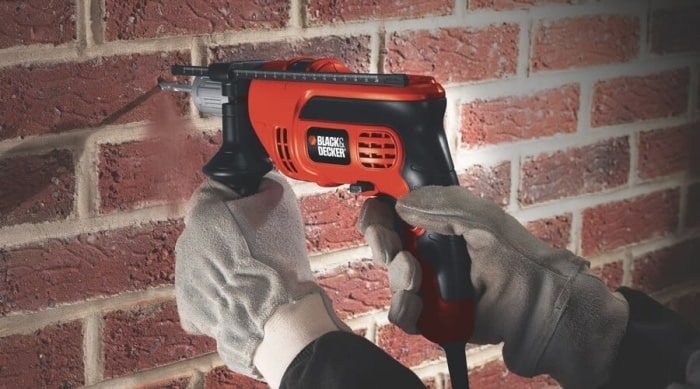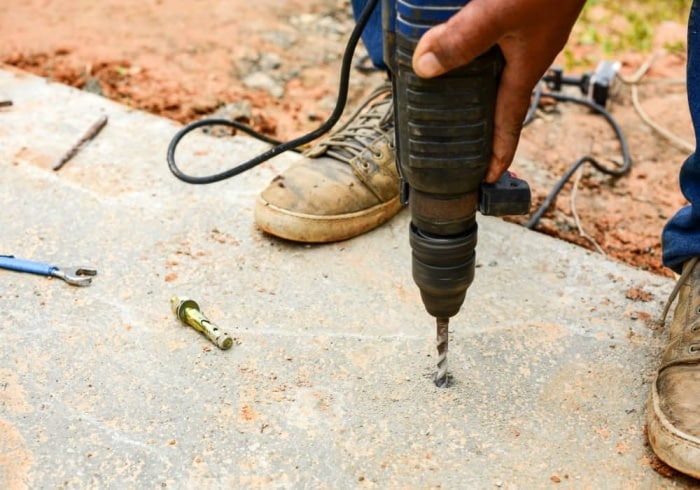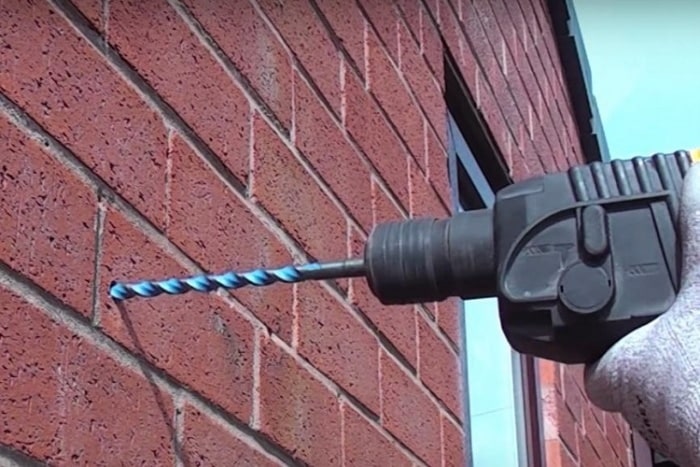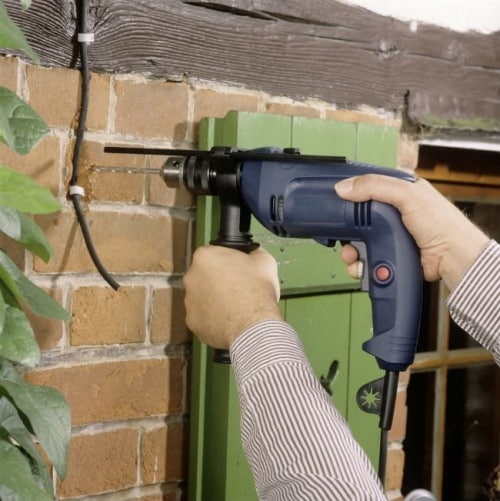Drilling into concrete bricks is more challenging than working on regular bricks, ordinary cement, or mortar as their surfaces are incredibly rigid.
The issue arises when you don’t have a power hammer drill around your garage.
Many home carpenters think that a concrete screwing project without a special hammer drill is impossible.
Indeed, you can find another possible way to carry out the job, though it may take some effort and patience. With an ordinary drill and concrete drill bits, you’re good to go.
How to screw into concrete without a hammer drill? We’ll guide you through five steps to deal with this ‘impossible mission’:
- Start with a tiny masonry drill bit
- Change to a larger one
- Work out hard blockages
- Apply some water to the bit
- Drill slowly
Also, this post includes some valuable tips on drilling into concrete effectively in default of a hammer drill.
What Do You Use Instead Of A Hammer Drill?
A hammer drill utilizes rotary movement and percussive action, making the drill twist while going up and down. This mechanism gives your device the power to punch hard.
Plus, hammer drills deliver a super-high frequency, keeping hitting the object material.
That’s why they excel at driving hardened drill bits into hard materials, like concrete, bricks, marble, or tiles, without overheating its motor or using various drill bits.
Power tools with special hammering features make the job much quicker and easier. However, it’s ok not to have one in your tool bag. A regular drill is also an excellent, dependable option.
A Regular Drill
Proceeding with an ordinary drill takes some extra steps and requires hard work because it doesn’t offer hammering features.
But with the right tool and fundamental knowledge of running a drill, the worker can still make progress.
It’ll be beneficial if your ordinary drill comes with an interchangeable head, speed settings, and adjustable torque as you’re going to attach masonry drill bits to the tool.
One thing to note is that you have to use more torque and lower speeds when screwing into concrete with a regular drill.
If you run it too fast, the drill bits might not be able to accommodate the extreme speed and malfunction. Also, reducing the speed provides you more significant control over the process.
So, you know why adjustable torque and speed are crucial for desired results. It’s still possible to do the job without these flexible features, but it’ll be much more difficult.
Masonry Drill Bits
Concerning screwing into concrete bricks, the best type of bit, so far, are masonry or concrete drill bits.
These attachments usually feature a thicker tip diameter and bring the benefits of a tungsten carbide material: hard to break and damage and master at dealing with heavy-duty constructions.
A regular drill is a perfect way to go for daily tasks, like cement or wood walls.
Nevertheless, the same doesn’t go for concrete, which could do with extra power during screwing.
That’s why a standard drill should tie-up with masonry drill bits to help the carpenter master robust concrete surfaces.
This combination turns the task easier and pushes the process efficiently.
How To Screw Into Concrete Without A Hammer Drill?
So, you don’t have a hammer drill at your fingertips now, which may, in part, affect the progress and level up the difficulty of the drilling job.
Don’t worry; you can work things out with the combination of a regular power tool, masonry drill bits, some effort, and dedication. We’re here to prove it’s the right set as an alternative to a hammering unit.
Before getting into the process, please keep in mind that a hammer drill should still be an ideal assistant for such types of jobs.
So if you frequently have to cope with concrete, invest in a high-quality power hammering tool to ensure the best efficiency for every project.
Start With A Small Masonry Drill Bit
It was wrong that many people used the drill bit with the most significant diameter to start digging into the material.
They were mistaken that a sizable diameter concrete drill bit would penetrate through the object more quickly. Actually, that’s not the right case, and this practice doesn’t work at all.
It would help to start with the smallest masonry drill tip to weaken the rigid concrete first, then create a tinier pilot hole. Please remember, your ordinary drill is not as powerful as a particular hammer drill.
Switch Another Larger Drill Bit
After cracking the material, you have successfully broken its surface, partially removing the debris and materials.
In the second drilling turn, you’ll find the hole much simpler to insert with a more considerable masonry drill bit.
You will need to re-do this process 2-3 times based on the size of the hole to correct it and finish the job.
Deal With Blockages
Sometimes, you might encounter a hard point where the masonry bit can’t glide through or go any deeper and seems to get stuck.
We can tell you’re hitting a blockage – a common problem when screwing into bricks, concrete, or mortar.
Don’t panic; you can work it out, though, by using a nail and hammer to break the blockage and dig through the wall. Remember to insert into the hole a long pin so it will be protruding.
You simply use the hammer to punch the nail, breaking through the obstacle. This practice should loosen all debris and enable you to proceed with the drilling process again.
Avoid applying excessive power when hitting the nail, or you might ruin the desired shape of the hole.
Keep The Bit Cool With Water
One helpful tip is to prepare a small bucket or cup of water beforehand for whenever you need to cool the drill’s tip down.
As said, a regular drill is not best at punching holes with concrete or masonry drill bits swiftly, so working for long hours may overheat the tip.
At times, you need to dip it into the water and wait for a few seconds. In so doing, you are cooling it down and leaving it some time to rest before you start screwing again.
When lowering the bit’s temperature, stay on the lookout for the motor. You have to make sure the drill’s engine won’t overheat because getting too hot may cause it to malfunction.
Should you be drilling over a couple of holes, then have a break at times to deter the motor from heating too much.
Drill Slowly
The enhanced difficulty and extra working time when using a regular drill might tempt you into going fast to finish the job more quickly. But it’s not a good idea to do so.
Masonry drill bits are pretty rigid yet somewhat brittle when rushing to rotate. Using a high speed can crack your masonry and overheat the drill’s motor.
An ordinary drill is never more effective than a hammer drill. We don’t recommend pounding away at the concrete while forcing the drill through as you could burn out its motor.
Thus, you should drill slowly and concentrate on efficiency rather than speed to achieve the desired hole.
What Are Tips For Drilling Into Concrete Without A Hammer?
One of the critical factors determining your work result is the masonry bits’ quality. Always pick ones from popular brands with a robust reputation and prestige for quality.
Concrete can crack low-quality masonry bits very easily. This crack will pose damage to your material and put you in danger in case the bit falls apart.
There’s also a possibility of broken masonry causing pieces of the concrete to fly around and hit you and others nearby.
That’s the reason you need to always pay full attention to your bit’s quality and keep an eye on any sign of damage or chipping to both the bit and the material.
If you notice any damage or wear, switch the bit out right away.
Another useful tip to bear in mind is to consider the concrete age when screwing into the object. A standard drill tends to deal with new concrete samples better than the old one.
If the material is too old, we advise you to work with a hammer drill instead.
Final Thoughts
How to screw into concrete without a hammer drill? Undeniably, drilling concrete with no use of a hammer drill is a demanding task.
When you have no idea what is the proper alternative to this powerful tool, the job is nearly an ‘impossible mission.’
Fortunately, our brilliant method should have assisted you greatly in dealing with concrete bricks. The ‘regular drill + masonry drill bits’ combo is truly a life savior for home DIYers lacking the right hammering tool.
After all, a hammer drill is still a go-to option regarding heavy-duty drilling projects. You’d better invest in one to enhance your performance.
Read more: How To Drill A Square Hole In Wood?




